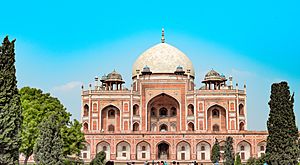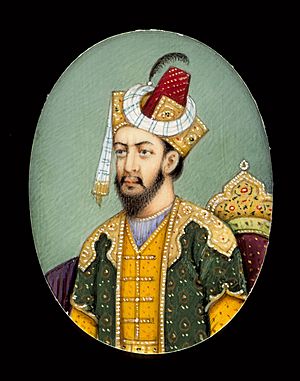Humayun's Tomb facts for kids
Humayun's Tomb (in Hindustani: Maqbara-i Humayun) is a famous tomb in Delhi, India. It is the resting place of Humayun, a powerful Mughal Emperor. His first wife, Empress Bega Begum (also known as Haji Begum), ordered its building in 1569-70. Persian architects, Mirak Mirza Ghiyas and his son Sayyid Muhammad, designed this amazing structure. The tomb was named a UNESCO World Heritage Site in 1993. This means it is a very important place for everyone in the world to protect.
Contents
Who Was Emperor Humayun?
Humayun was the second Mughal Emperor. The Mughal Empire was a very large and powerful empire in India. Humayun ruled from 1530 to 1540, and again from 1555 to 1556. His father was Babur, who started the Mughal Empire. Humayun faced many challenges during his rule. After his death, his wife, Empress Bega Begum, decided to build a grand tomb for him. This tomb would show the power and importance of the Mughal rulers.
Building a Grand Tomb
The Vision of Empress Bega Begum
Empress Bega Begum was Humayun's chief wife. She loved him very much and wanted to create a special resting place for him. She spent a lot of her own money to build this tomb. She chose skilled Persian architects, Mirak Mirza Ghiyas and his son, Sayyid Muhammad, to design it. This was a huge project that took many years to finish.
Amazing Design and Architecture
Humayun's Tomb is famous for its unique design. It was the first garden-tomb on the Indian subcontinent. It also inspired many later Mughal buildings, including the famous Taj Mahal. The tomb is built mostly from red sandstone. It has white marble details, especially on its large dome.
The tomb stands in the center of a huge square garden. This garden is divided into four main parts by walkways and water channels. This style of garden is called a Charbagh, which means "four gardens." It is a traditional Persian garden style. The tomb itself is built on a large platform. It has many arches and windows, making it look very grand.
A UNESCO World Heritage Site
In 1993, Humayun's Tomb was recognized as a UNESCO World Heritage Site. This means it has great cultural and historical importance to all of humanity. UNESCO helps to protect and preserve these special places around the world. Being a World Heritage Site helps make sure that Humayun's Tomb will be cared for and enjoyed by future generations.
The Beautiful Gardens
The gardens around Humayun's Tomb are just as important as the tomb itself. They are designed in the traditional Persian Charbagh style. This style represents the gardens of Paradise mentioned in Islamic texts. The garden is divided into four squares by water channels and paths. Each square is then divided into smaller squares, creating a beautiful pattern.
The water channels are an important part of the design. They help to cool the air and create a peaceful atmosphere. The gardens are filled with green lawns, trees, and flowers. They provide a calm and beautiful setting for the grand tomb.
Other Tombs in the Complex
The Humayun's Tomb complex is not just about Humayun. It also has many other smaller tombs and buildings. Over 150 Mughal family members are buried here. Some of the notable structures include:
- Isa Khan Niyazi's Tomb: This tomb was built in 1547, even before Humayun's Tomb. Isa Khan was a noble in the court of Sher Shah Suri. His tomb is a beautiful example of Afghan architecture.
- Nila Gumbad: Also known as the "Blue Dome," this tomb was built around 1625-26. It is known for its bright blue tiles.
- Barber's Tomb (Nai Ka Gumbad): This small tomb is believed to be the resting place of Humayun's favorite barber. It is located near the main tomb.
These other structures add to the historical richness of the complex. They show how important this area was for the Mughal rulers and their families.
Images for kids
-
Mughal Emperor, Humayun r. 1508–1556
-
Capture of the last Mughal emperor Bahadur Shah Zafar and his sons by William Hodson at Humayun's tomb in September 1857
-
Nila Gumbad ca 1625–6, built by courtier Abdul Rahim Khan-I-Khana
-
Cenotaphs of Hamida Banu Begum, Dara Shikoh etc. in a side room
See also
 In Spanish: Tumba de Humayun para niños
In Spanish: Tumba de Humayun para niños



























